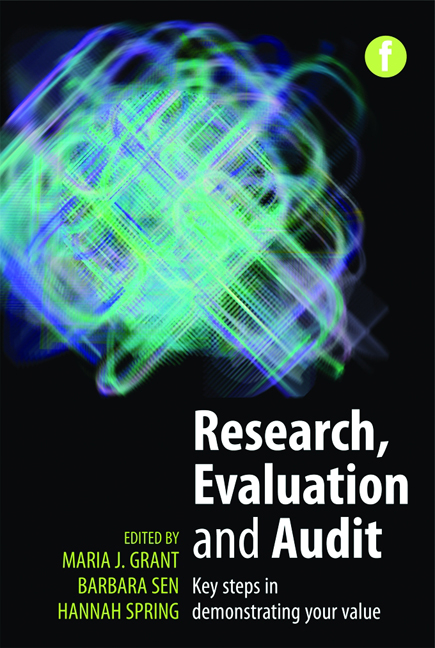Book contents
- Frontmatter
- Contents
- About the Editors
- Contributor
- Foreword
- Preface
- PART 1 GETTING STARTED
- PART 2 DOING RESEARCH, EVALUATION AND AUDIT
- PART 3 IMPACT OF RESEARCH, EVALUATION AND AUDIT
- 11 Writing up your project findings
- 12 Disseminating your project findings
- 13 What next? Applying your findings to practice
- Closing remarks
- Index
12 - Disseminating your project findings
from PART 3 - IMPACT OF RESEARCH, EVALUATION AND AUDIT
Published online by Cambridge University Press: 08 June 2018
- Frontmatter
- Contents
- About the Editors
- Contributor
- Foreword
- Preface
- PART 1 GETTING STARTED
- PART 2 DOING RESEARCH, EVALUATION AND AUDIT
- PART 3 IMPACT OF RESEARCH, EVALUATION AND AUDIT
- 11 Writing up your project findings
- 12 Disseminating your project findings
- 13 What next? Applying your findings to practice
- Closing remarks
- Index
Summary
‘What exactly is dissemination?’
‘My work is specific to my library; I doubt anyone else would be interested in it.’
‘When should dissemination be planned?’
Introduction
Dissemination can be a confusing term and its definition can depend on context. As library and information practitioners, many of us are familiar with dissemination as it applies in the term ‘selective dissemination of information’ or SDI. Whilst this term is also open to interpretation, it usually means a current awareness service which involves screening documents to select information to meet the specific research needs of a user and delivering that information directly to them (Hossain and Shiful, 2008). Dissemination is one of as many as 29 terms identified and used to describe knowledge to action; others include knowledge translation, knowledge transfer, knowledge exchange, research utilization, implementation and diffusion (Graham et al., 2006).
In the context of this chapter dissemination is a term used to describe ways to alert interested parties to your research findings and encourage the uptake of that evidence into practice. No particular theory or model is being advocated; presented here are ideas and suggestions to establish or improve the dissemination of research.
Dissemination is an integral part of the research process and is often included as a requirement in a researchfunding contract. Dissemination can become complex, because it involves a number of processes and different target groups, but it can and should be viewed as just another part of the wider research process. In addition to planned dissemination activities, approaches and opportunities to disseminate findings may present themselves during the research. As suggested in Chapter 11, if you are new to project work you may wish to consider approaching an experienced colleague or mentor in your workplace for their advice in developing your dissemination plan.
Plan and evaluate
A dissemination plan may contain five major elements (Carpenter et al., 2005):
What is going to be disseminated
Who are the end users
Dissemination partners
How to disseminate
Evaluation.
- Type
- Chapter
- Information
- Research, Evaluation and AuditKey steps in demonstrating your value, pp. 203 - 214Publisher: FacetPrint publication year: 2013



